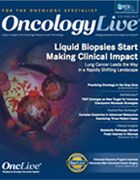Publication
Article
Oncology Live®
Rolling Out Technology
Author(s):
It is always a balancing act to describe the introduction of new technology in the medical field. We seek to juggle enthusiasm for the potential of an exciting new platform with the complexities of the long road ahead that adopting new technology usually bring.
OncLive Chairman,
Mike Hennessy
It is always a balancing act to describe the introduction of new technology in the medical field. We seek to juggle enthusiasm for the potential of an exciting new platform with the complexities of the long road ahead that adopting new technology usually bring.
The cover story in this issue, “Liquid Biopsies Start Making Clinical Impact,” captures this dilemma. In some respects, the ability to perform liquid biopsies in solid tumors is having a notable impact in lung cancer and has thus entered clinical practice. In other ways, the clinical utility of conducting liquid biopsies, regardless of the type of technology employed, must still be established before it is truly useful in daily oncology practice.
There are so many potential uses for liquid biopsies across the spectrum of cancer care—and so many companies chasing these possibilities—that it’s easy to get carried away. The possible uses include screening, diagnosing recurrence, identifying mutations, and directing therapy.
The reality underlying these exciting prospects is that there often is doubt about whether an identifiable mutation is driving the malignancy and whether there is an available targeted therapy to attack the aberrations that testing uncovers. Then there are questions about comparing tests and results.
These considerations point to the need for the oncology research establishment to organize a framework that sets standards for liquid biopsies and guides clinicians in evaluating testing options. The federal government is organizing collaborations that might help.
One example is the Blood Profiling Atlas, which is part of the Cancer Moonshot initiative. This project will bring together 20 leading industry and academic entities, with pharmaceutical and diagnostic companies partnering with cancer centers, to build a database for laboratory and clinical findings regarding liquid biopsies. The strategy will be similar to the approach used several years ago when the FDA tapped a next- generation sequencing database to approve a new screening test for cystic fibrosis.
The development of liquid biopsies is one of the major trends that we will be following this year. Please let us know what you would like to learn about this exciting new technology. As always, thank you for reading.










